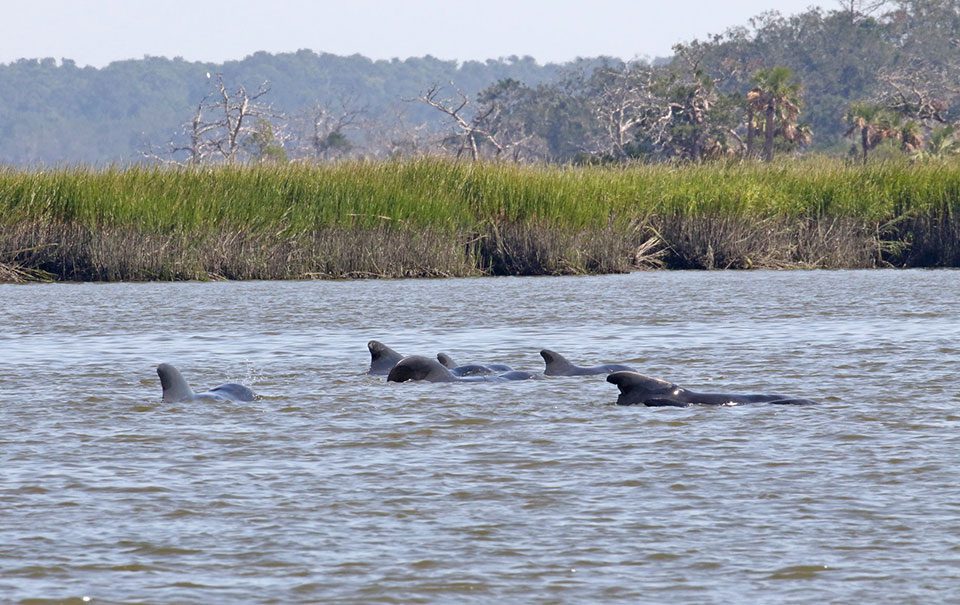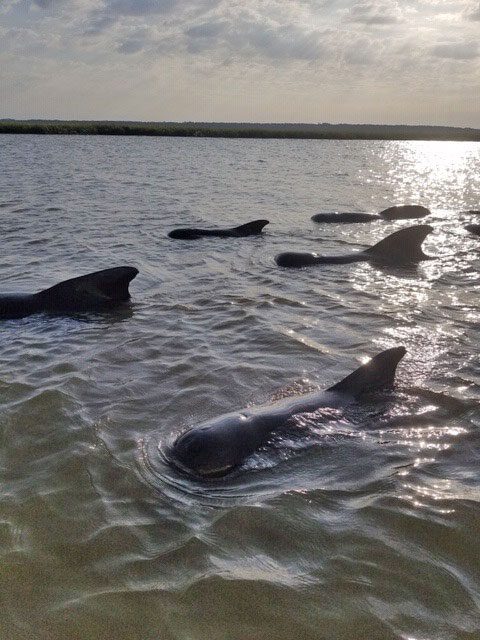BRUNSWICK, Ga. (Sept. 26, 2019) – Approximately 26 short-finned pilot whales stranded on or near St. Catherines Island Wednesday, leaving 15 dead in Georgia’s second mass stranding of these large marine mammals this year.
St. Catherines, the Georgia Department of Natural Resources and the National Oceanic Atmospheric Administration responded. Staff from the Georgia Sea Turtle Center and the Florida Fish and Wildlife Conservation Commission have also helped.
Why the whales beached themselves isn’t known. Necropsies, or animal autopsies, are being done to assess what the animals’ health condition had been and to search for possible clues to the stranding.
Short-finned pilot whales are a deep-water species usually found off the continental shelf and slope, as far as 100 miles offshore. Yet these social animals – which travel in pods sometimes numbering in the hundreds – are also the most common species to mass-strand in the southeastern U.S.
On July 16, at least 47 pilot whales were involved in a mass stranding on St. Simons Island. Three whales died. No cause for that mass stranding has been determined, and it’s not known yet if any survivors were part of the St. Catherines mass stranding.
St. Catherines is privately owned and not open to the public. The St. Catherines Island and Edward J. Noble foundations support conservation of island resources, plus extensive research and education.
St. Catherines staff found 11-13 whales stranded on the remote island Wednesday morning, according to island director of operations Mike Halderson. Five were alive. Using tarps, tow ropes and vehicles, staff carefully returned four of the whales to the water. The fifth died before it could be moved.
“It was an all-hands-on-deck situation,” Halderson said.
Short-finned pilot whales can weigh more than 3 tons and reach 24 feet in length.
Later Wednesday, DNR confirmed that five pilot whales had stranded in the marsh. Small groups also were seen swimming that day in a tidal creek and in Sapelo Sound.
On Thursday, checks by helicopter and boat spotted no live whales or additional dead ones as of noon, leaving the live whales seen Wednesday unaccounted for. Monitoring is continuing.
Necropsies involving NOAA, DNR, St. Catherines and Dr. Terry Norton of the Georgia Sea Turtle Center are being conducted to the extent possible given logistics at the remote sites and the decomposition of carcasses. Some results may not be available for months.
DNR senior wildlife biologist Clay George emphasized, however, that the mass stranding on St. Catherines is “clearly not related to” the capsized freighter in St. Simons Sound. The straight-line distance from the ship to the mass stranding site is more than 30 miles.
WHAT YOU CAN DO
Reporting a stranded marine mammal is the best way to make sure trained responders and scientists know about it and can take appropriate action. If you see a sick, injured, stranded or dead marine mammal, immediately contact Georgia DNR at 1-800-2-SAVE-ME (800-272-8363) or the Southeast U.S. Marine Mammal Stranding Network at 877-WHALE HELP (877-942-5343).
NOAA also offers the free Dolphin and Whale 911 app to report a stranded marine mammal. Download the app through the Apple or Google Play Store.
SHORT-FINNED PILOT WHALES/AT A GLANCE
• Live in social groups of tens to hundreds of whales.
• Found worldwide in tropical and warm temperate waters.
• Inhabit deep water along the continental shelf and slope.
• Feed primarily on squid but may also feed on octopus and fish, typically at depths of 1,000 feet or more.
• May live 50-70 years.
• Most common species to mass strand in the southeastern U.S.
• Protected under the Marine Mammal Protection Act.
• For more: www.fisheries.noaa.gov/species/short-finned-pilot-whale
Source: NOAA
WHY DO PILOT WHALES MASS STRAND?
Mass strandings of dolphins, whales and other marine mammals date back to the time of Aristotle. There are many theories or possible reasons why whales may mass strand. Those include:
• They are highly cohesive animals and when one is sick or ill, others may stay close by, even if it means coming to shore and becoming sick, debilitated or stranded themselves.
• Biotoxins.
• Underwater noise (sonar, seismic testing, etc.).
• Anomalies in the magnetic field.
• Location – Some places experience mass strandings on a regular basis (e.g., Cape Cod). Many of these sites share similar traits, including a hook-shaped land mass jutting out into the water, gently sloping beaches and convoluted estuarine systems.
• Tides.
• Extreme weather.
• Disease/parasites.
Source: NOAA
PILOT WHALE MASS STRANDINGS SINCE 1991 IN THE SOUTHEAST
• Since 1991, there have been 26 pilot whale mass strandings in the southeastern U.S.
• The St. Catherines mass stranding is the second of pilot whales in Georgia and the third in the Southeast this year. At least 47 pilot whales mass-stranded on St Simons Island on July 16 and there was a mass stranding of five pilot whales on Redington Beach, Fla., July 29.
• Mass strandings in the Southeast have ranged from two to 51 whales.
• Most occurred in Florida (77%). There also have been two mass strandings in North Carolina, two in Georgia, one in South Carolina and one in Puerto Rico.
• Of those in Florida, 25% were on the state’s northeast coast. The rest were in the Florida Keys or on the Gulf coast, primarily from southwest Florida through the Keys.
• Searches of historical records by DNR and The Brunswick News found that, before 2019, the last known mass stranding of pilot whales in Georgia occurred in February 1977, when 15 whales stranded and died on Cumberland Island near the Georgia/Florida line. They were part of a larger mass stranding that left more than 150 whales dead from Mayport, Fla., to Rockville, S.C.

